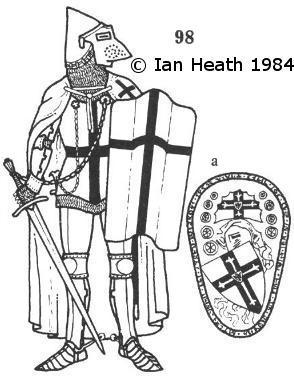
Try Amazon Fresh
TEUTONIC KNIGHT c. 1400
An extract from Armies of the Middle Ages, Volume 2by Ian Heath



98. TEUTONIC KNIGHT c. 1400
Throughout this period Teutonic Knights would have been armed like their lay contemporaries elsewhere in Germany (though admittedly the 1348 seal of the Livonian Landmeister still depicts a brother knight apparently equipped exactly as shown in Armies of Feudal Europe). The principal difference, of course, was that brethren of the Order wore a white jupon marked with a black cross, apparently with silver piping, as depicted here (but only in the case of knights; serving brethren wore instead a grey surcoat with a black tau cross, i.e. a cross with no upper arm, looking like a capital ‘T’). Except for his Hundsgugel (‘hound’s hood’) helmet, this particular figure is from the brass of Kuno von Liebensteyn, Komtur of Strassburg 1389-91, and portrays typical late-14th/early-15th century armour of the type that most of the Order’s knights doubtless wore at Tannenberg in 1410; the cloak is unlikely to have often been worn in battle, though at Tannenberg the Hochmeister, Ulrich von Jungingen, appears to have worn his over his gilt armour (perhaps to conceal it and thus make himself somewhat less conspicuous). Fra Kuno’s shield is white with a black cross like his jupon, and is of a type with a prominent raised central rib that originated in Lithuania (see figure 142). It seems to have been the principal type of shield used by the Order by the late-14th century, also being depicted held by St Maurice on one side of the Livonian banner, shown in 103x, captured in 1431. 98a depicts an earlier 14th century shield of characteristic Prussian shape, belonging to Hochmeister Karl Beffart von Trier (1310-19).
[Based on the Brass of Kuno von Liebensteyn, Teutonic Knight. Poland, c.1400.]